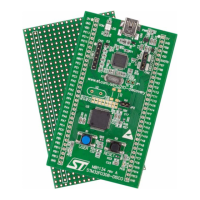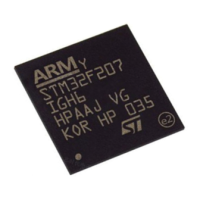Debug support (DBG) RM0008
1066/1096 Doc ID 13902 Rev 12
Example of configuration
To output a simple value to the TPIU:
● Configure the TPIU and assign TRACE IOs by configuring the DBGMCU_CR (refer to
Section 31.17.2: TRACE pin assignment and Section 31.16.3: Debug MCU
configuration register)
● Write 0xC5ACCE55 to the ITM Lock Access Register to unlock the write access to the
ITM registers
● Write 0x00010005 to the ITM Trace Control Register to enable the ITM with Sync
enabled and an ATB ID different from 0x00
● Write 0x1 to the ITM Trace Enable Register to enable the Stimulus Port 0
● Write 0x1 to the ITM Trace Privilege Register to unmask stimulus ports 7:0
● Write the value to output in the Stimulus Port Register 0: this can be done by software
(using a printf function)
Table 225. Main ITM registers
Address Register Details
@E0000FB0 ITM lock access
Write 0xC5ACCE55 to unlock Write Access to the other ITM
registers
@E0000E80 ITM trace control
Bits 31-24 = Always 0
Bits 23 = Busy
Bits 22-16 = 7-bits ATB ID which identifies the source of the
trace data.
Bits 15-10 = Always 0
Bits 9:8 = TSPrescale = Time Stamp Prescaler
Bits 7-5 = Reserved
Bit 4 = SWOENA = Enable SWV behavior (to clock the
timestamp counter by the SWV clock).
Bit 3 = DWTENA: Enable the DWT Stimulus
Bit 2 = SYNCENA: this bit must be to 1 to enable the DWT to
generate synchronization triggers so that the TPIU can then
emit the synchronization packets.
Bit 1 = TSENA (Timestamp Enable)
Bit 0 = ITMENA: Global Enable Bit of the ITM
@E0000E40 ITM trace privilege
Bit 3: mask to enable tracing ports31:24
Bit 2: mask to enable tracing ports23:16
Bit 1: mask to enable tracing ports15:8
Bit 0: mask to enable tracing ports7:0
@E0000E00 ITM trace enable
Each bit enables the corresponding Stimulus port to generate
trace.
@E0000000-
E000007C
Stimulus port
registers 0-31
Write the 32-bits data on the selected Stimulus Port (32
available) to be traced out.
